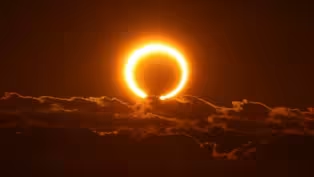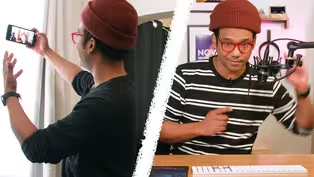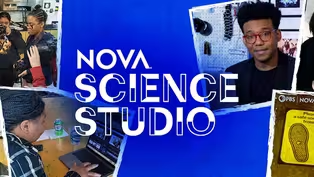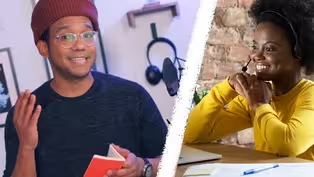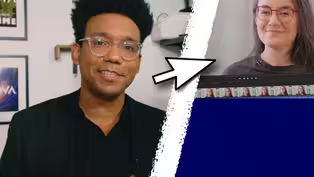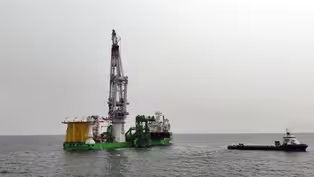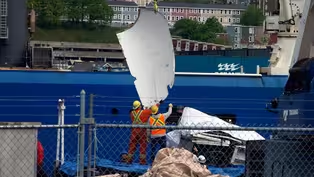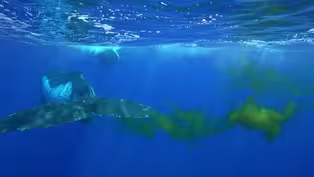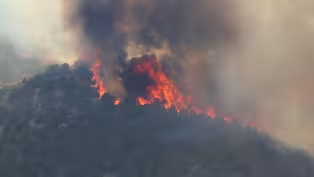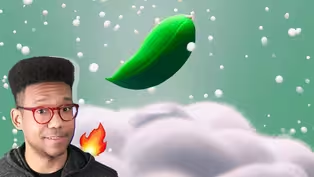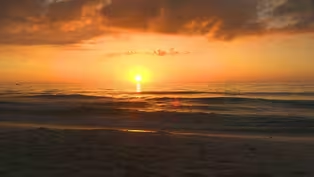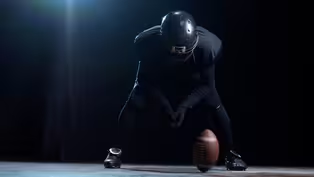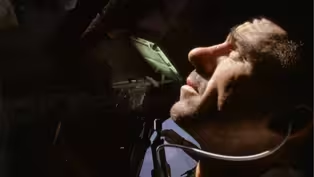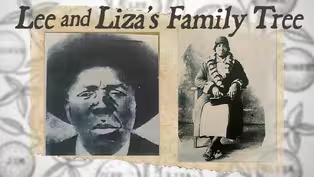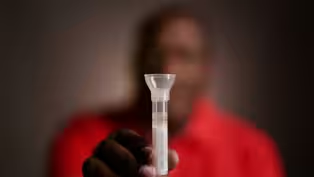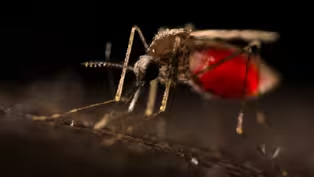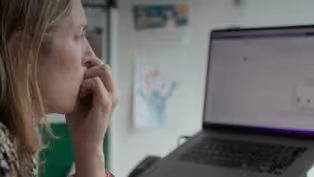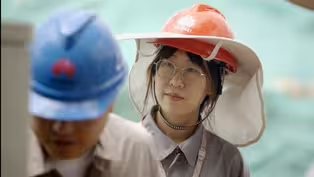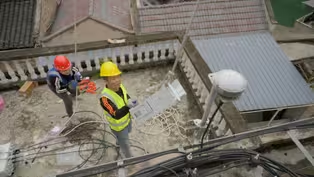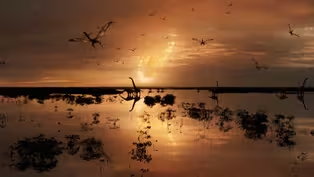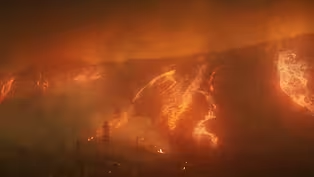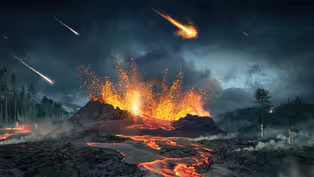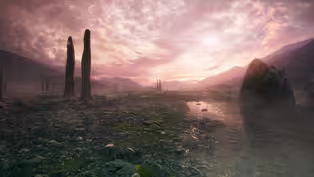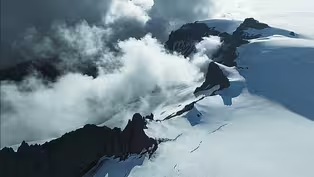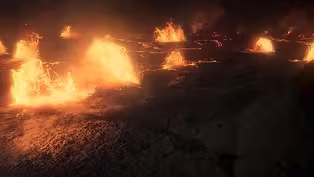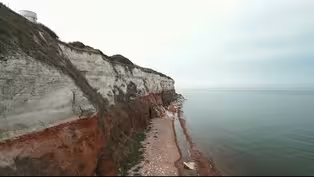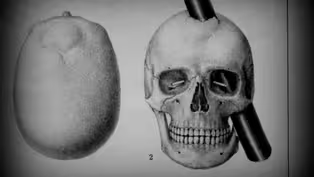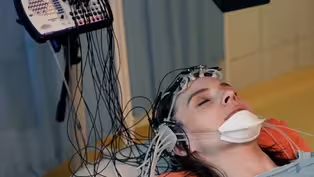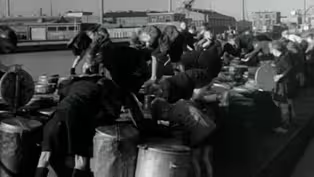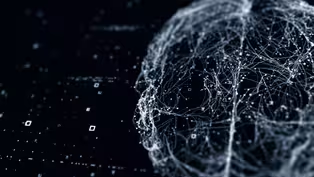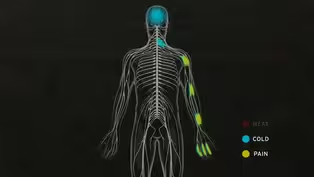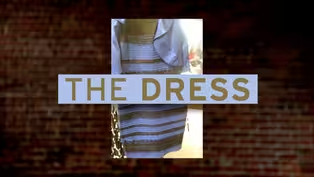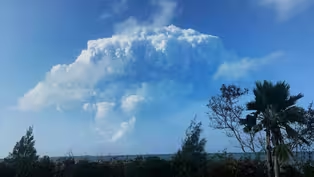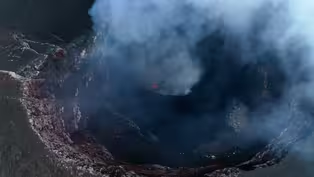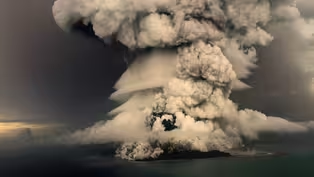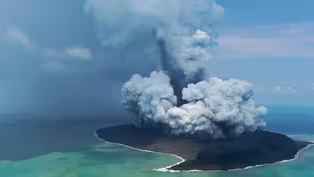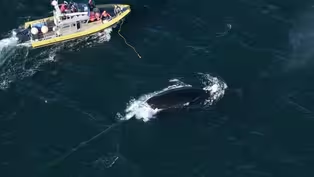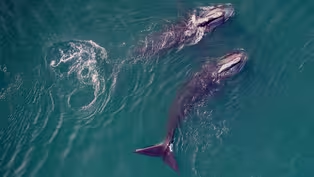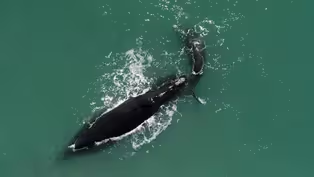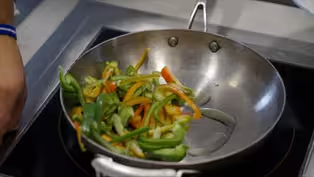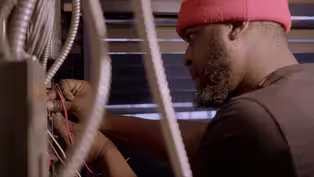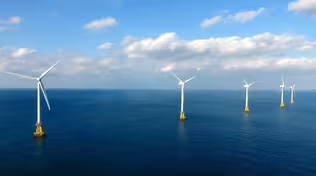
The nation’s first big offshore wind farm is coming
Clip: Season 50 | 5m 22sVideo has Closed Captions
The first commercial-scale offshore wind farm in the US is being built off Massachusetts.
Offshore wind has been slow to take off in the US, compared to Europe. So, why now? What will the impacts be?
Problems playing video? | Closed Captioning Feedback
Problems playing video? | Closed Captioning Feedback
National Corporate funding for NOVA is provided by Carlisle Companies and Viking Cruises. Major funding for NOVA is provided by the NOVA Science Trust, the Corporation for Public Broadcasting, and PBS viewers.

The nation’s first big offshore wind farm is coming
Clip: Season 50 | 5m 22sVideo has Closed Captions
Offshore wind has been slow to take off in the US, compared to Europe. So, why now? What will the impacts be?
Problems playing video? | Closed Captioning Feedback
How to Watch NOVA
NOVA is available to stream on pbs.org and the free PBS App, available on iPhone, Apple TV, Android TV, Android smartphones, Amazon Fire TV, Amazon Fire Tablet, Roku, Samsung Smart TV, and Vizio.
Buy Now

NOVA Labs
NOVA Labs is a free digital platform that engages teens and lifelong learners in games and interactives that foster authentic scientific exploration. Participants take part in real-world investigations by visualizing, analyzing, and playing with the same data that scientists use.Providing Support for PBS.org
Learn Moreabout PBS online sponsorship- This giant tube is part of the first big offshore wind farm in the US now under construction off the coast of Massachusetts.
The company behind the project, Vineyard Wind says a single spin of one of the turbines could power a home for a day and 62 of these each, more than twice as tall as the Statue of Liberty, are being installed about 34 miles from this beach.
When complete Vineyard Wind says the project will be barely visible from nearby islands and will power over 400,000 homes and businesses.
But there are now a number of offshore wind projects in development.
In fact, by 2030, the US aims for offshore wind to generate 30 gigawatts of energy enough to power about 10 million homes.
Still, offshore wind has been slow to spin up in the US compared to Europe where there are thousands of wind turbines.
So why offshore wind?
What kind of impact will it have and why now?
- A lot has evolved.
It's taken a lot of time to develop the regulatory situation to get various stakeholders comfortable.
The economic environment.
- [Caitlin] The prospects for abundant clean energy from wind becomes pretty obvious.
When you look at a map of where the wind blows the most, that's the dark blue.
There's a lot of it in this center of the country where many onshore wind farms have sprung up but most of the population lives closer to the coasts and it's hard to transmit energy that far.
- It's extremely challenging to build long transmission lines when it comes to getting permitting rights across multiple states.
- [Caitlin] But just offshore, there's a whole lot more dark blue, and that wind is close to the large population centers in the US.
The trick is getting it to shore.
- To build out a grid that can take the power from this location to where the load centers are.
That is a huge part of ensuring that this industry is successful.
- So how do they do it?
For Vineyard Wind, cables carrying the electricity are buried under the sea floor and come ashore under this beach.
From here, they continue underground over four miles to this place.
Whoa, that's kind of cool looking.
A substation that converts the electricity to a voltage that then feeds into the electrical grid.
Every big wind project will have to make landfall somewhere that requires construction and a substation, both of which can be disruptive and the effects of construction extend offshore too, like on the fishing industry and marine animals.
These are some of the reasons why offshore wind has faced a lot of opposition in the US.
- During construction.
That will probably be the time when they are the most significant impacts, for example, on commercial fishing.
So even if you could fish there there probably wouldn't be many fish to catch.
- [Caitlin] That's because noise can be disruptive to marine animals and driving a pile for a wind turbine is pretty loud.
- Sound travels exceptionally well underwater because sound is conducted very well by seawater but the travel path of that sound is disrupted when the sound wave hits an air pocket in the water because air is not as good a conductor of sound as water is.
- [Caitlin] One solution that Vineyard Wind is using is as simple as it is clever.
Create a curtain of bubbles.
Yeah, bubbles.
- The idea of the bubble curtains is to put hoses on the seabed around the turbine tower and force pressurized air out of small holes in those hoses.
The idea is that that air bubble curtain will impede the transmission of the sound.
It won't stop it but it will make the signal much less loud.
- [Caitlin] Once construction is over, the fishes and fishing should return.
- There may be some changes in the distribution of species as a result of the presence of the wind farm.
For example, the additional structure that's now in the water there may attract certain species of fish that wouldn't have been there in that abundance previously.
- [Caitlin] Wind developers will need to take a number of precautions to protect the marine environment but nothing can fully protect from all harm and global warming itself could cause far more damage than wind farms to the ocean ecosystems.
- My personal view is that the change is worth pursuing in the interest of slowing the negative effects on our ocean ecosystem that global warming and climate change is having right now.
It's not free.
It comes at a cost and that's a trade-off that we have to consider when we decide to put wind farms into the ocean.
- Some think that we should be focusing more on developing different carbon-free energy technologies like solar and nuclear.
They too come with trade-offs.
It's still early days for the US offshore wind industry and there are a lot of complexities to navigate from the marine environment to the fishing and shipping industries to residents.
- We really are in a situation where we have to decide what changes and sacrifices.
In some instances we are prepared to make to ensure that our grandchildren have a workable and livable planet.
What to know about the “Ring of Fire” Eclipse
Video has Closed Captions
Clip: S50 | 46s | The "Ring of Fire" eclipse is coming. Seriously, don’t look directly at it. (46s)
Mastering Lighting and Audio in Video | NOVA Science Studio
Video has Closed Captions
Clip: S50 | 4m 4s | Elevate lighting and audio with these techniques to highlight creative storytelling (4m 4s)
Introducing the NOVA Science Studio Program
Video has Closed Captions
Clip: S50 | 2m 42s | The NOVA Science Studio is a youth science journalism program for high school students. (2m 42s)
How To Film Great Video With A Phone | NOVA Science Studio
Video has Closed Captions
Clip: S50 | 3m 54s | NOVA producer Alex Clark shares 3 fundamentals of shooting with a smartphone. (3m 54s)
How To Do A Video Interview | NOVA Science Studio Tutorial
Video has Closed Captions
Clip: S50 | 3m 56s | Interviewing is one of the most important parts of creating compelling videos (3m 56s)
Complete Guide To Editing | NOVA Science Studio Tutorials
Video has Closed Captions
Clip: S50 | 16m 21s | Learn editing tips and techniques to ensure a cohesive story from start to finish (16m 21s)
Rare Fossil Appears to Show Mammal Attacking Dinosaur
Video has Closed Captions
Clip: S50 | 3m 26s | Could a small mammal take down a dinosaur? (3m 26s)
The nation’s first big offshore wind farm is coming
Video has Closed Captions
Clip: S50 | 5m 22s | The first commercial-scale offshore wind farm in the US is being built off Massachusetts. (5m 22s)
What Made the Titan Submersible Design Unconventional?
Video has Closed Captions
Clip: S50 | 5m 5s | An international investigation into the fatal submersible implosion is underway. (5m 5s)
Could Whale Poop Help Cool the Planet?
Video has Closed Captions
Clip: S50 | 2m 43s | Marine biologists unravel how whales and their poop trap carbon and feed the ocean. (2m 43s)
This Fungus Is Spreading Rapidly in Hospitals
Video has Closed Captions
Clip: S50 | 3m 24s | Cases of Candida auris are increasing every year. (3m 24s)
There’s Something Living in Wildfire Smoke
Video has Closed Captions
Clip: S50 | 1m 59s | Wildfire smoke can carry harmful microorganisms long distances. (1m 59s)
How the West Is Making It Rain, With Science
Video has Closed Captions
Clip: S50 | 6m 22s | A method of boosting snow and rainfall may help ease drought conditions in the western US. (6m 22s)
Soothing Science: The Light You See at Sunset
Video has Closed Captions
Clip: S50 | 8m 1s | Relax to the sound of the ocean and discover the science behind sunsets. (8m 1s)
The Mystery and Physics of the Spiral Football Pass
Video has Closed Captions
Clip: S50 | 3m 43s | The way the spiral football pass travels through the air baffled physicists for years. (3m 43s)
Astronaut Walter Cunningham on the Historic Apollo 7 Mission
Video has Closed Captions
Clip: S50 | 32m 26s | He discussed the first crewed Apollo mission, Apollo 7, with NOVA in 1998. (32m 26s)
Lee and Liza's Family Tree Preview
Video has Closed Captions
Preview: S50 Ep18 | 30s | A family turns to science in their struggle to rediscover a history obscured by slavery. (30s)
Can DNA technology Help Rebuild a Family Tree?
Video has Closed Captions
Clip: S50 Ep18 | 3m 28s | A Black family uses DNA technology to unlock secrets of the past. (3m 28s)
Why Mosquitos Are Humanity’s Deadliest Creature
Video has Closed Captions
Clip: S50 Ep17 | 3m 37s | About 80% of deaths caused by Malaria annually are young children, below the age of five. (3m 37s)
Inside the Fight To Develop a Malaria Vaccine
Video has Closed Captions
Clip: S50 Ep17 | 4m 18s | These scientists were on the verge of a breakthrough with a promising vaccine nearing approval. (4m 18s)
Video has Closed Captions
Clip: S50 Ep17 | 2m 34s | Today, Malaria is considered a tropical disease, but it wasn’t always that way. (2m 34s)
Inside Huawei: China’s Tech Giant
Video has Closed Captions
Clip: S50 Ep16 | 3m 40s | Working at Huawei can be intense - six day weeks and 12 hour days are the norm. (3m 40s)
Inside China's Tech Boom Preview
Video has Closed Captions
Preview: S50 Ep16 | 30s | The inside story of China’s meteoric rise to the forefront of global innovation. (30s)
Video has Closed Captions
Clip: S50 Ep16 | 4m 28s | A tech war between China and the West is starting to heat up. (4m 28s)
What Caused the Dinosaurs to Go Extinct?
Video has Closed Captions
Clip: S50 Ep15 | 1m 50s | How did an asteroid impact on one side of the planet cause global devastation? (1m 50s)
The Catastrophe That Killed 90% Of Earth’s Species
Video has Closed Captions
Clip: S50 Ep14 | 1m 34s | An ancient catastrophe killed nearly all life on Earth - and an asteroid wasn’t to blame. (1m 34s)
Ancient Earth: Inferno Preview
Video has Closed Captions
Preview: S50 Ep14 | 30s | How did life bounce back after a cataclysmic extinction wiped out some 90% of all species? (30s)
Giant Prehistoric Fungi Once Ruled the Earth
Video has Closed Captions
Clip: S50 Ep13 | 3m 43s | Fossils show that millions of years ago, 20-foot-high fungi grew on Earth. (3m 43s)
How Life Survived When Earth Was Covered in Ice
Video has Closed Captions
Clip: S50 Ep12 | 3m 6s | Hundreds of millions of years ago, Earth was encased in ice. How did life survive? (3m 6s)
Video has Closed Captions
Clip: S50 Ep11 | 3m 9s | For millions of years, Earth was a fiery hellscape, inhospitable to life. (3m 9s)
Ancient Earth May Have Had Red Oceans
Video has Closed Captions
Clip: S50 Ep11 | 3m 34s | On Ancient Earth, rust deep in the oceans played a critical role in the formation of Earth (3m 34s)
Your Brain: Who's in Control? Preview
Video has Closed Captions
Preview: S50 Ep10 | 29s | Dive into the subconscious to see what’s really driving the decisions you make. (29s)
What If Part of Your Brain Was Missing?
Video has Closed Captions
Clip: S50 Ep10 | 2m 29s | An injury cost Phineas Gage part of his brain, but he lost something else too. (2m 29s)
What Happens in the Brain When you Sleepwalk?
Video has Closed Captions
Clip: S50 Ep10 | 3m 55s | Some people can do complex behaviors like walking and driving while sleeping. (3m 55s)
How Trauma Can Alter Your Biology
Video has Closed Captions
Clip: S50 Ep10 | 4m 40s | Your ancestors' experiences might influence how your brain is wired today. (4m 40s)
Your Memories Are Not as True as You Think
Video has Closed Captions
Clip: S50 Ep9 | 3m 51s | It turns out memories have a very shaky foundation. (3m 51s)
Your Brain: Perception Deception Preview
Video has Closed Captions
Preview: S50 Ep9 | 29s | Neuroscientists discover the tricks and shortcuts the brain takes to help us survive. (29s)
Is the Human Brain Actually Two Minds?
Video has Closed Captions
Clip: S50 Ep9 | 5m 17s | Severing the connection between the two halves of the brain reveals how the hemispheres function. (5m 17s)
Video has Closed Captions
Clip: S50 Ep9 | 3m 40s | This experiment shows how the brain can interpret — and misinterpret— pain. (3m 40s)
How Your Brain Interprets Color
Video has Closed Captions
Clip: S50 Ep9 | 2m 24s | A vision scientist breaks down the infamous dress debate. (2m 24s)
Witnesses Recount Surviving a Volcanic Explosion
Video has Closed Captions
Clip: S50 Ep8 | 2m 57s | Hear witnesses share how they survived the most explosive event ever recorded on Earth. (2m 57s)
Scientists Make Rare Discovery in Active Volcano
Video has Closed Captions
Clip: S50 Ep8 | 2m 58s | Volcanologists visit Tofua to study the volcano’s activity. (2m 58s)
How an Underwater Volcano Produced a 60-Foot Tsunami
Video has Closed Captions
Clip: S50 Ep8 | 2m 35s | The most explosive event ever recorded on Earth—and the massive tsunami that followed. (2m 35s)
Video has Closed Captions
Preview: S50 Ep8 | 30s | Investigate one of the most powerful volcanic eruptions in recorded history. (30s)
Scientists Attempt To Free Entangled Right Whale
Video has Closed Captions
Clip: S50 Ep7 | 3m 30s | Entanglement responders work to free a critically endangered whale from rope. (3m 30s)
Saving the Right Whale Preview
Video has Closed Captions
Preview: S50 Ep7 | 27s | Follow scientists determined to save the critically endangered right whale. (27s)
Meet Snow Cone the Right Whale and Her Calf
Video has Closed Captions
Clip: S50 Ep7 | 4m 32s | Since 2010, the average time between North Atlantic right whale births has increased. (4m 32s)
Why Induction Stoves Are Better for You and the Environment
Video has Closed Captions
Clip: S50 Ep6 | 2m 56s | Induction stovetops are an energy-efficient alternative to traditional gas stoves. (2m 56s)
How Heat Pumps Can Help Cities Lower Carbon Emissions
Video has Closed Captions
Clip: S50 Ep6 | 4m 17s | Landlords are switching from gas furnaces to heat pumps to reduce their carbon footprint. (4m 17s)
Chasing Carbon Zero Sneak Peek
Video has Closed Captions
Clip: S50 Ep6 | 1m | A new film from NOVA examines technologies that could get us to carbon zero by 2050. (1m)
Providing Support for PBS.org
Learn Moreabout PBS online sponsorship
- Science and Nature

Capturing the splendor of the natural world, from the African plains to the Antarctic ice.













Support for PBS provided by:
National Corporate funding for NOVA is provided by Carlisle Companies and Viking Cruises. Major funding for NOVA is provided by the NOVA Science Trust, the Corporation for Public Broadcasting, and PBS viewers.


